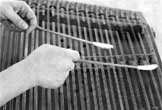The Santouri or Greek dulcimer
 |
The santouri, shaped like an equal-sided trapezoid, belongs to the family of stringed instruments. It is tuned chromatically, extending over three and a half octaves.
Constructed from timber selected for its resonant qualities, it usually has 96-115 strings. Every note is represented by one to five identically tuned strings.
The strings are attached to adjustable keys, placed at the right side of the resonator, called "Balkoni" (balcony) in Greek. They stretch horizontally and are fixed to the left side with small nails. This side is called the "Koutsouro" (log).
Five sets of bridges divide the four sections of the Santouri: the counter-bass, the bass, the middle and the high. The first set of bridges is positioned in the lower left corner of the instrument, close to the left balcony, the widest side of the trapezoid. The second set is placed at the right side of the sound-box. They extend from the wide to the narrow side, almost parallel to the right balcony. The third set, almost in the middle of the sound-box, has twelve bridges. Five smaller ones in the upper right corner and three in the upper left make up the remaining two sets.
The sound is produced by striking the strings with two specially-designed light-weight sticks. Each one has a hook-shaped handle and a 5mm wide, 20-25 cm long baton, with a curved end.
Depending on the type of sound desired (harsh, mellow, etc.) the curved end can be wrapped or tied with cotton, thread or rubber.
Baguette strumming requires special techniques, interchanging simultaneous with successive beats. Strumming one string with both baguettes at once is called "German" or "Double stick", whereas with alternating beats is called "simple".
The musician can place the santouri either on his lap or on a small table. Also, if he necessary, and particularly when playing "patinades", he can hang it from his neck, as these songs need the musician to be able to walk about freely in village precincts.
It is a polyphonic instrument and is used in Greek music to play the main melody, to accompany another solo instrument or for improvisation.
Melody playing predominates in the Aegean islands. On the mainland the role of the santouri is mainly restricted to accompanying other solo instruments. To do this, the musician must be familiar with the rhythm and harmonic analysis of the songs.
Last, but not least, he can improvise, creating one or several phrases spontaneously. Improvisation, however, follows given 'paths'. The musician moves freely within these parameters, according to his spiritual mood, his personal experiences and his musical training.
Santouri players distinguish two kinds of improvisation: the "Taximi" and the "Doina".
A taximi usually has free tempo, and follows the scales or 'roads' of Byzantine music, known to traditional musicians by their Arabic or Persian names.
The word 'Doina' is Rumanian. Improvisation is restricted to a chromatic scale, called 'Vlachiki' ('Of the Vlachs'), or the 'Makam Nikriz'.
Improvisation parts are usually heard at the beginning, at the end or in the middle of the main melody.